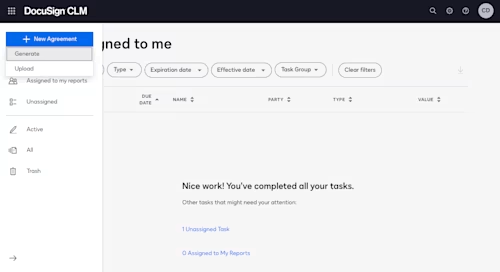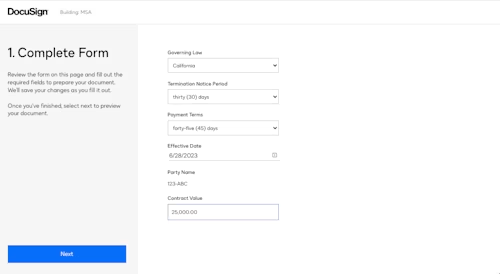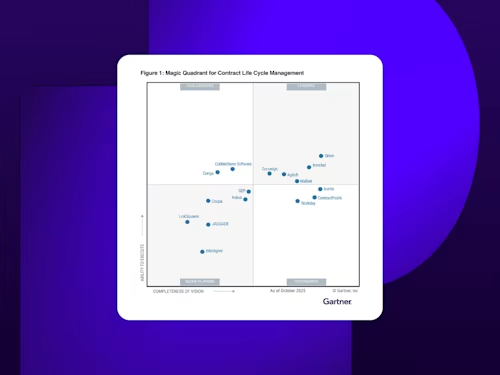
How to Create a Contract with Docusign CLM in 3 Steps
Here’s a quick overview of how you can use Docusign CLM to create a new agreement in three simple steps.

Creating a contract can be clunky and cumbersome without a central tool to manage and automate the process. Different contract types require unique pieces of information stored in separate systems and need to comply with different internal and external policies. At scale, those complexities can add up to a slow, disjointed workflow with too much room for error.
That’s why Docusign CLM includes an agreement generation tool. Teams can take advantage of CLM’s guided experience to create common contracts and ensure that all new agreements have a similar structure and common language. This functionality also drastically reduces the amount of time and effort employees spend writing new contracts.
How to create a contract using Docusign CLM
Here’s a quick overview of how you can use Docusign CLM to create a new agreement in three simple steps:
1. Open the “New Agreement” workflow from your CLM homepage
At the top of the navigation menu, the first option is “New Agreement.” Once you click that option, you’ll be able to generate a new agreement or upload one that’s already been started. To start creating an agreement inside CLM, click “Generate.”

2. Select a template and recipient
In the next step, you’ll be prompted to select which type of contract you want to create and who you’re creating it for. You can start with any contract template that your CLM admin has set up, so it’s up to your team to build a list of common contract types (MSAs, SOWs, NDAs, etc) and upload standardized templates.

3. Enter contract details using a form
Based on the requirements of the template you selected in the previous step, you’ll see a form to provide details that are required for that type of contract. Some of these items may require you to type in unique information, others will be as simple as selecting the right option from a short list. In some cases, CLM will apply conditional logic to pull in new language from your clause library or customize information requests based on answers to previous questions.

Once those three steps have been completed, CLM will merge the information you provided into the selected template to create a new contract. In a lot of cases, the entire contract generation process can be completed with a few clicks in less than a minute.
What happens next is up to you. If you want to review the contract to make sure everything is accurate, you can preview the agreement in CLM or save it to read later. If you’re comfortable with the contents of your new contract, you can send it directly to the next recipient. That may be an external party who needs to sign to agree to the terms you just created. It could be the case that certain types of contracts need to go through additional rounds of review with colleagues. Whatever needs to happen next in your workflow, your account can be set up to kick off that step automatically.
Simplifying contract generation further with integrations
Our three-step approach to contract generation is pretty straightforward, but integrating CLM with critical systems of record can make the process go even faster and smoother. Those integrations allow CLM to pull existing information out of other systems, which streamlines the third step in the contract creation process.
In some cases, it’s even possible to create a contract with a single click. For example, Docusign Gen for Salesforce and CLM for Salesforce allow teams to automate the entire contract creation process without leaving the Salesforce environment. Basic contracts that don’t require any customization or negotiation can be created in Salesforce with one click and sent with another.
For more complex agreements, CLM has tools to support any level of customization without sacrificing efficiency or consistency. It serves as a central platform to create an agreement that blends information from a range of sources, including your team’s preapproved legal language and data held in other critical business systems like Coupa, SAP Ariba, Netsuite and Workday. With those integrations, Docusign customers can automatically pull data into their contracts, which reduces the amount of time spent transferring information and improves accuracy.
If your team needs to create fast, efficient agreements, CLM can help. It can even guide you through the experience with simple, clear prompts. If you need to pull information from multiple systems and put together a highly customized contract that will be negotiated through several versions, it can handle that too. Whatever you need out of your contract creation process, CLM has tools to make the job faster and easier.
Scaling contracting efficiencies to a global team
Today’s leading organizations are using CLM to reinvent their contract generation workflows. For example, Unilever undertook an initiative to re-engineer its contract creation process with Docusign, replacing manual one-off tasks with a standardized central hub that can accommodate the entire document lifecycle.
Before implementing Docusign, Unilever’s contracting processes were spread across different systems and “We were missing opportunities on standardization and the efficiencies and benefits that come from that,” said Wei Ling Lim, Unilever’s general counsel for global supply chain. “We wanted tools and solutions that would harmonize, simplify and bring efficiencies.”
For Unilever, the contracting initiative was a clear success—reducing contract drafting time by 80% and improving visibility across global operations. More efficient contracts meant faster overall speed of business and made work easier for the entire organization.
To learn more about our vision for a simplified agreement workflow in Docusign CLM, download the Gartner Magic Quadrant for CLM.
Related posts
Docusign IAM is the agreement platform your business needs


